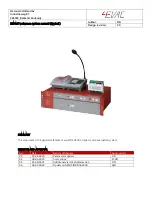
Description
Design guidelines
7159-9001-108
01. February 2020
animal identification
When planning the system, follow all of the instructions for the components
used!
7160-90 . . -422
Identification frame
Ear identification
7160-90 . . -423
Neck/leg identification
7160-90 . . -427
Transmitter/receiver
VP1801
Minimum distance to other identification systems (6 m)
Attention!
In order to rule out the possibility of two identification systems affecting each
other, a distance of at least 6 m is to be retained between identification
systems!
Space required for animal segregation
● Minimum length required for the segregation system: 5.60 m
Alley width
The maximum permissible width of the passageway in front of the segregation
system is 90 cm so that the animals are only able to enter the segregation area one
at a time.
Screen
If animals can see other animals while they are in the segregation passageway,
these animals often remain standing in the passageway and hold up the constant
flow of animals.
This results in a reduction in throughput and a hold-up as far back as the milking
parlour or carousel is possible.
Therefore, it is advisable to provide a screen (at least 160 cm high) in the form of
a wall of plastic panels in the segregation passageway.
Segregation bay
● The segregation bay must be at least big enough to accommodate all the
animals segregated during a milking session.
Space required: at least 5 square metres per animal.
● The animals must be able to move about freely inside it.
● Fresh basic feed, drinking water and possibly a cattle brush ensure that the
animals are comfortable in the bay.
The ideal solution is a self-retaining grille with sufficient feeding places for the
segregated animals where they are retained during the milking session.
Setting: DPService 010/000/013
See the option ”Automatic gate locking system”
Note:
If these points are not observed, the segregated animals might leave the
segregation bay again and go back towards the milking parlour/rotary milking
parlour.
















































